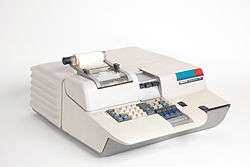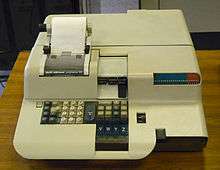Programma 101
 A Programma 101 | |
| Type | programmable desktop calculator, arguably the first personal computer. |
|---|---|
| Release date | 1965 |
| Memory | 240 bytes |
| Successor | Programma P102 |
The Olivetti Programma 101, also known as Perottina or P101, is the first commercial programmable "desktop computer".[1][2][3] Produced by Italian manufacturer Olivetti, based in Ivrea, Piedmont, and invented by the Italian engineer Pier Giorgio Perotto, the P101 had the main features of large computers of that period. It was launched at the 1964 New York World's Fair; volume production started in 1965. A futuristic design for its time, the Programma 101 was priced at $3,200[4] (equivalent to $24,800 in 2017). About 44,000 units were sold, primarily in the US.
It is usually called a printing programmable calculator or desktop calculator because its arithmetic instructions correspond to calculator operations.[5]
Capabilities

The Programma 101 is able to calculate the basic four arithmetic functions (addition, subtraction, multiplication, and division), plus square root, absolute value, and fractional part. It is equipped with memory registers with features such as clear, transfer, and exchange, plus printing and halt for input.
Programming is similar to assembly language, but simpler, as there are fewer options. It directs the exchange between memory registers and calculation registers, and operations in the registers. There are 16 jump instructions and 16 conditional jump instructions. Its features of conditional jump instructions, an alphanumeric programming language, an internal memory, and a data storage system define it as a "computer". Thirty-two label statements were available as destinations for the jump instructions and/or the four start keys (V, W, Y, Z).[6]
There are 10 memory registers: three for operations (M, A, R); two for storage (B, C); three for storage and/or program (assignable as needed: D, E, F); and two for program only (p1, p2). Each full register held a 22-digit number with sign and decimal point or 24 instructions each consisting of a letter and a symbol.[7] Five of the registers (B, C, D, E, F) could be subdivided into half-registers, containing an 11-digit number with sign and decimal point. So its most distinctive structural difference from later computers is that its instruction space and its data space are functionally separate.
The stored programs can be recorded onto plastic cards approximately 10 cm × 20 cm that have a magnetic coating on one side and an area for writing on the other. Each card can be recorded on two stripes, enabling it to store two programs. Five registers are stored on the card; two registers are dedicated to the program code, other three registers (D, E, F) can be used for the code or for numbers. Instructions occupy one byte, and a magnetic card can hold 120 instructions. In large computers such as the Elea 9003, an instruction occupies 8 bytes, 120 instructions occupy nearly 1 Kbytes; the total memory is 20 Kbytes in basic models.
Earlier computers were expensive and could only be used by experts. The P101 was easy and economical, and programs on magnetic cards, in a simple machine language, allows use without knowing the programming language.[8][9][10][11][12]
It prints programs and results onto a roll of paper tape, similar to calculator or cash register paper.
Construction
A total of 240 bytes of information were electrically stored in magnetostrictive delay-line memory, which had a cycle time of 2.2 milliseconds. Computation was effected by discrete devices (transistors and diodes mounted on phenolic resin circuit card assemblies), as there were no microprocessors, and even integrated circuits were in their infancy.
Design and ergonomics
Olivetti was famous for its attention to both engineering and design aspects, as the permanent collection at the Museum of Modern Art testify. The Programma 101 was another example of this attention. Engineering-wise, the team worked hard to deliver a very simple product, something that anyone could use. To take care of the ergonomics and aesthetics of a product that didn't exist before, Roberto Olivetti called Mario Bellini, a young Italian architect:
I remember that one day I received a call from Roberto Olivetti: "I want to see you for a complex project I'm building". It involved the design not of a box containing mechanisms and stamped circuits, but a personal object, something that had to live with a person, a person with his chair sitting at a table or desktop and that had to start a relationship of comprehension, of interaction, something quite new because before then computers were as big as a wardrobe. With a wardrobe we don't have any relationship: in fact the most beautiful wardrobes disappear in the wall. But this wasn't a wardrobe or a box, this was a machine designed to be part of your personal entourage.
— Mario Bellini, 2011, "Programma 101 — memory of the future", cit.
Interaction design and usability

One of the direct results of the Programma 101 team focus on human-centered objectives was the invention of the programmable magnetic card, a revolutionary item for that time allowing anyone to just insert it and execute any program in a few seconds.[13]
It was a very portable and effective solution: a small magnetic strip with a program memorized in it and a space on the other side to write the description. The program was loaded just by inserting the card at the top, and when the card came out at the bottom, it was aligned perfectly with the V, W, Y, Z keys in a way that the author could have written on the card the labels for these buttons, to make the user aware of their new function.[14]
History
It was designed by Olivetti engineer Pier Giorgio Perotto in Ivrea. The styling, attributed to Marco Zanuso but in reality by Mario Bellini, was ergonomical and innovative for the time, and earned Bellini the Compasso d'Oro Industrial Design Award.
Developed between 1962 and 1964, it was saved from the sale of the computer division to GE thanks to an employee who one night changed the internal categorization of the product from "computer" to "calculator", leaving the small team within Olivetti and creating some awkward situations in the office, since the building except that office was then owned by GE.[15] In 1961, Olivetti built a much bigger computer co-developed by Federico Faggin that served as a model for the programmable calculator.[16]
The Programma 101 was launched at the 1964 New York World's Fair, attracting major interest. 40,000 units were sold; 90% of them in the United States where the sale price was $3,200[4] (increasing to about $3,500 in 1968.[6])
Hewlett-Packard was ordered to pay about $900,000 ($6.99 million in present-day terms [17]) in royalties to Olivetti after copying some of the solutions used in the Programma 101, like the magnetic card and the architecture, in the HP 9100.[18][19]
About 10[20] Programma 101 were sold to NASA and used to plan the Apollo 11 landing on the Moon.
By Apollo 11 we had a desktop computer, sort of, kind of, called an Olivetti Programma 101. It was a kind of supercalculator. It was probably a foot and a half square, and about maybe eight inches tall. It would add, subtract, multiply, and divide, but it would remember a sequence of these things, and it would record that sequence on a magnetic card, a magnetic strip that was about a foot long and two inches wide. So you could write a sequence, a programming sequence, and load it in there, and the if you would – the Lunar Module high-gain antenna was not very smart, it didn't know where Earth was. [...] We would have to run four separate programs on this Programma 101 [...]
— David W. Whittle, 2006 [21]
The P101 is mentioned as part of the system used by the US Air Force to compute coordinates for ground directed bombing of B-52 Stratofortress targets during the Vietnam War.[22]
References
- ↑ "'Desk-top' computer is typewriter size". Business Week. October 23, 1965.
- ↑ "Desk-Top Size Computer Is Being Sold by Olivetti For First Time in US". The Wall Street Journal. October 15, 1965.
- ↑ "2008/107/1 Computer, Programma 101, and documents (3), plastic / metal / paper / electronic components, hardware architect Pier Giorgio Perotto, designed by Mario Bellini, made by Olivetti, Italy, 1965-1971". www.powerhousemuseum.com. Retrieved 2016-03-20.
- 1 2 "Cyber Heroes: Camillo Olivetti". Hive Mind. Retrieved 2010-11-07.
- ↑ "Olivetti Programma 101 "Perottina"".
- 1 2 Bell, C. Gordon; Newell, Allen (1971). "Chapter 19: The Olivetti Programma 101 desk calculator". Computer Structures: Readings and Examples. McGraw-Hill. p. 235. ISBN 0-07-004357-4. Retrieved 2009-12-17.
- ↑ Wladimir Zaniewski (2016-09-04), Olivetti Programma 101 - Utilizzo dei registri, retrieved 2016-09-04
- ↑ 101proj (2010-12-21), Programma 101 – Memory of Future, retrieved 2016-03-20
- ↑ Archivio Nazionale Cinema d'Impresa (2013-12-03), Spot - Olivetti - calcolatore - Programma 101, retrieved 2016-03-20
- ↑ "The incredible story of the first PC, from 1965". Pingdom Royal. Retrieved 2016-04-04.
- ↑ "101 Project". www.101project.eu. Retrieved 2016-04-04.
- ↑ "Premio Perotto - Press". www.piergiorgioperotto.it. Retrieved 2016-04-04.
- ↑ "Programma 101". Old Calculator Web Museum.
- ↑ Bonomi, Francesco. "The Programma 101 Magnetic Card". IT: Silab.
- ↑ "Programma 101 Memory of the Future / Quando Olivetti Inventò il PC". History Channel. YouTube. June 26, 2011.
- ↑ "Oral History of Federico Faggin" (PDF). Computer History Museum. 2006.
- ↑ Federal Reserve Bank of Minneapolis Community Development Project. "Consumer Price Index (estimate) 1800–". Federal Reserve Bank of Minneapolis. Retrieved January 2, 2018.
- ↑
"Olivetti Programma P101/P102". Old Computers.
The P101, and particularly the magnetic card, was covered by a US patent (3,495,222, Perotto et al.) and this gave to Olivetti over $900.000 in royalties by HP alone, for the re-use of this technology in the HP9100 series.
Missing or empty|url=(help) - ↑ Perotto, Pier Giorgio (February 10, 1970). "3,495,222 Program Controlled Electronic Computer" (multiple). United States Patent Office. et al. Google patents. Retrieved November 8, 2010.
- ↑ "Programma 101 Memory of the Future / Quando Olivetti Inventò il PC". History Channel. June 26, 2011.
- ↑ Whittle, David W (Feb 16, 2006). Johnson, Sandra, interviewer, transcriptor &, ed. "NASA Space Center" (PDF). Oral History Project. Houston, TX.
- ↑ Shawcross (1991). "Bombing Cambodia: A Critique". In Rotter, Andrew. Light at the end of the tunnel: A Vietnam War Anthology. New York. p. 280. ISBN 0-312-04529-8.
External links
- 101 Project, official site of 101 initiative documentary project.
- Bonomi, Francesco, Description of the P-101, IT: Silab, retrieved 2009-12-17 .
- Olivetti, Programma 101 General Reference Manual, hosted by the Old Calculator Web Museum, retrieved 2009-12-17.
- Internal pictures Old Calculator Web Museum.
| Wikimedia Commons has media related to Olivetti Programma 101. |
- A simulator of the Olivetti Programma 101.
- "General Reference Manual". Old Calculator Museum.
- A Technical Description of the Olivetti Programma 101 with a picture gallery, by Alfredo Logioia.